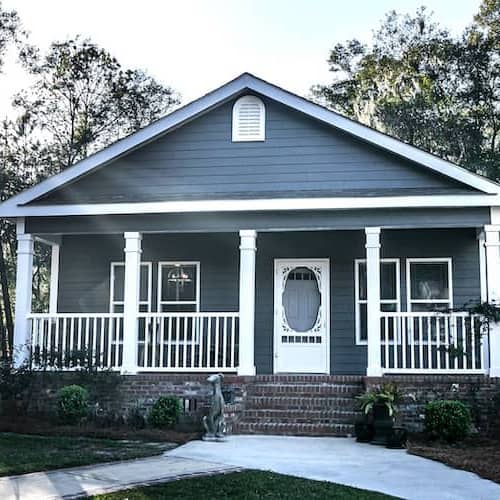Building a manufactured home: A closer look at how manufactured homes are built
Contributed by Sarah Henseler
Oct 24, 2025
•5-minute read

Approximately 22 million Americans live in manufactured homes, accounting for around 7% of housing units. While you can find some in urban areas, the majority are located in more rural areas of the country.
If you’re considering this path, you can finance one through a manufactured home loan, including with Rocket Mortgage®. Here’s what you need to know about how to build a manufactured home and what it could cost.
What is a manufactured home?
A manufactured home is a type of housing that’s built in a factory, transported to its site, and assembled piece by piece. While the terms modular and manufactured home are sometimes used interchangeably, they’re not exactly the same. Manufactured homes are built to a national HUD Code, while modular homes must meet local and state building codes. These differences in modular versus manufactured homes affect not only how they’re constructed, but also where they can be placed and how they’re regulated.
It’s also important to note that manufactured homes built before June 15, 1976, are referred to as mobile homes. That date marks when the new federal safety and construction standards were introduced.
Here are some key characteristics of what defines a manufactured home:
- They are prefabricated in a factory, piece by piece.
- They are built using codes established by the Department of Housing and Urban Development (HUD).
- Unlike modular homes, which must follow state and local codes, manufactured homes follow one uniform national code.
- They must have a permanent chassis.
- They can be placed on a temporary or permanent foundation.
How are manufactured homes built?
Unlike traditional homes that are constructed entirely on-site, manufactured homes are built in a factory setting as a type of prefab home. The process starts off-site, where the home is assembled piece by piece under controlled conditions. Once the structure is complete, it’s transported and delivered to the site of your choice.
One advantage of this approach is speed. Because most of the work happens indoors and without weather delays, building a manufactured home can take as little as one week in some cases.
Let’s take a look at the step-by-step process of how a manufactured home comes together.
Step 1: Design your manufactured home
The first step in building a manufactured home is customization. Manufactured homes can be tailored to fit your needs, starting with selecting the overall size, then choosing a floor plan and finishes that match your wants, needs, and budget. You’ll also have options for materials such as flooring, cabinets, and countertops.
Manufactured home customization usually comes first because your contractor or builder will likely need to submit blueprints and plans with your permit before construction can move forward.
Step 2: Secure permits and understanding zoning laws
Before placing a manufactured home on its final site, you’ll need to make sure the land is zoned for this type of residential housing. Zoning laws vary by city and state, so it’s important to confirm that your property meets the local requirements before moving forward.
The permitting process can take time. For example, in California, one company says it can take 4 - 6 months to secure all necessary permits. Your exact timeline will depend on local regulations and how quickly your municipality processes applications.
Step 3: Prepare the site
Before placing the manufactured home, the land must be ready. About 40% of manufactured homes are located in manufactured home communities, where the land is leased, while the other 60% sit on owned land.
If your home is being placed in a community, preparing the site could include:
- Clearing the land of trees, rocks, or debris.
- Grading the land so it’s level and stable.
- Setting up connections for water, sewer, and electricity.
- Establishing a permanent or temporary foundation, depending on your long-term plans.
Step 4: Off-site construction
The next step is assembly, which is done in an off-site factory before being transported and installed. By doing this, builders can avoid weather delays, and it allows each step to be monitored closely, so the home meets HUD standards. Here’s what typically happens during off-site construction:
- Prefab parts, including walls and the roof, are assembled.
- Fixtures are also installed, such as bathroom sinks.
- Final touches, like painting and tiling, may also take place now.
Step 5: Inspection and certification
Every manufactured home must pass a thorough home inspection to make sure it meets safety and construction standards set by the HUD. Inspectors will check:
- Body and frame
- Thermal protection
- Roof
- Plumbing
- Electrical
- Structural stability
Once the home meets these requirements, it receives a certification label, often called a HUD tag. This small red label, attached to the exterior of each section of the home, shows that it complies with federal standards.
Step 6: Delivery and installation
The final step is bringing the manufactured home to its permanent location. During this stage, the home is placed on its prepared foundation and secured with an anchoring system designed for the local soil and conditions.
All major systems, including plumbing, electrical, and HVAC, are connected, so the home is fully functional. Once complete, you’ll have a move-in-ready space that meets both your design choices and HUD’s safety standards.
To make sure the installation is done correctly, many states offer lists of HUD-approved installers who are trained and licensed for this process.
How much does it cost to build a manufactured home?
The manufactured home cost will depend on the size of the home, the number of sections, and the upgrades you choose. In 2024, the average price of a new manufactured home was just over $109,000.
That price can increase if you add custom features or opt for a multisection layout. For example, the average cost of a new multisection manufactured home is $164,678.
Should you buy or build a manufactured home?
Whether you decide to buy or build a manufactured home comes down to your goals, budget, and location. Like any housing choice, there are both advantages and challenges to keep in mind.
Pros
- Affordable: Manufactured homes generally cost less than on-site built homes.
- Customizable: You can design a home that fits your lifestyle and budget, from floor plans to finishes.
- Can hold value: With regular maintenance and the right location, manufactured homes can retain and even increase in value over time.
Cons
- Zoning: Not all land is zoned for manufactured homes, which can limit where you’re able to place your home.
- Financing: It may be more challenging to get financing compared to a traditional home.
The good news is that some lenders, including Rocket Mortgage, do offer financing options for manufactured homes. Loan types can include:
- Chattel mortgage: A loan for the home itself if the land isn’t owned.
- FHA loan: Backed by the Federal Housing Administration, offering lower down payment requirements.
- Conventional loan: Available if the home meets specific requirements.
Should you buy or build a manufactured home?
Manufactured homes also offer benefits beyond affordability. They are constructed with quality and durability in mind, in addition to the strict federal standards that ensure safety and energy efficiency.
Their longevity is often comparable to that of traditional site-built homes, with the added versatility of relocation. The manufactured home construction process also allows for quicker occupancy compared to traditional homes, making it an efficient solution for many homebuyers.
Quality assurance and financing options
There were initial concerns regarding the quality of manufactured homes in their early years. However, studies done on manufactured homes from the 1990s onwards demonstrate that these homes can match the quality of site-built homes when properly looked after.
One such study, by the Harvard Joint Center for Housing Studies, concluded that manufactured homes placed on land owned by the homeowner have been shown to appreciate in value at rates comparable to site-built homes. The findings of this analysis emphasize that a variety of manufactured homes remain a cost-effective option, as much as 73% less expensive than similar site-built homes.
The bottom line: Manufactured homes are an affordable alternative to stick builds
Choosing a manufactured home can give you the benefits of affordability, customization, and modern quality standards without the higher costs of traditional stick-built homes. They’re built in a controlled environment, inspected for safety, and delivered ready to move in. While factors like zoning and financing require some planning, loan options are available.
Ready to explore your financing options? Start an application today with Rocket Mortgage.

Josephine Nesbit
Josephine Nesbit is a full-time freelance writer specializing in real estate, mortgages, and personal finance. Her work has been featured in U.S. News & World Report, GoBankingRates, Homes.com, Fox Business, USA Today Homefront, and other publications where she helps readers navigate the housing market and manage personal finances.
Related resources

5-minute read
Building a manufactured home: A closer look at how manufactured homes are built
Thinking of buying or building a manufactured home? Learn more about how they’re made, what they cost, and how they differ from traditional homes.
Read more
6-minute read
Modular vs. manufactured homes: What's the difference?
Modular and manufactured homes are both factory-built, but they have some key differences. Uncover the distinctions between modular and manufactured homes.
Read more
7-minute read
What do manufactured homes cost?
Interested in purchasing a manufactured home? Uncover the average manufactured home cost and learn about the factors that influence manufactured home prices.
Read more